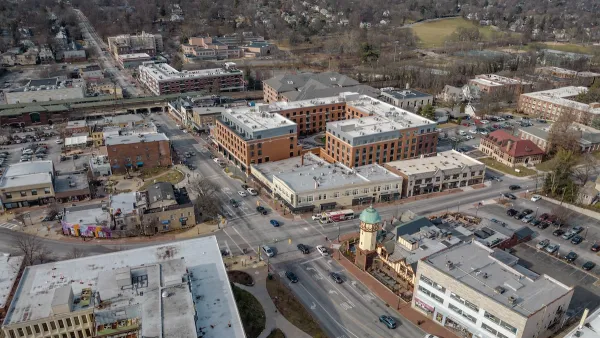On a recent business trip to Australia, I had the opportunity to visit with an interesting group of social planners called The Hornery Institute. Specifically, their charter is “to assist communities in becoming better places to live, learn, work and play.” The Hornery Institute was established in November 2000, in recognition of Lend Lease’s Chairman, Stuart Hornery and his commitment to community and people. To mark his retirement, the shareholders and employees of this great company formed a not-for-profit organization that allowed Hornery and his dedicated, hand-picked staff to continue working on independent projects to make communities more fulfilling.
On a recent business trip to Australia, I had the opportunity to visit with an interesting group of social planners called The Hornery Institute. Specifically, their charter is "to assist communities in becoming better places to live, learn, work and play." The Hornery Institute was established in November 2000, in recognition of Lend Lease's Chairman, Stuart Hornery and his commitment to community and people. To mark his retirement, the shareholders and employees of this great company formed a not-for-profit organization that allowed Hornery and his dedicated, hand-picked staff to continue working on independent projects to make communities more fulfilling.
The Hornery Institute's (THI) office is located in a wonderful success story they helped create called the Kelvin Grove Urban Village. Situated within short walking distance of Brisbane's CBD, the Village is a 16 hectare (40 acre) public/private master planned community anchored by the campus of Queensland University of Technology, the adaptive reuse of the Gona Army Barracks and Parade Grounds and supported by the Government of Queensland Department of Housing. The project brings together residential, educational, retail, health, recreational, business and creative industry uses, while respecting the site and its history. The Parade Grounds serve as urban plazas and the Turrbal people, who were the traditional owners of the land had input into landscaping and public art features throughout. For both visitors and residents, the planning and design of the Village feels both fluid and inviting from almost every direction. http://www.kgurbanvillage.com.au/
THI characterizes the Kelvin Grove Urban Village as being different from other ‘inner-urban suburbs'. This unique term is not part of the planning vocabulary used in the United States and appears to be authentically Australian. Also, this community type appears to blur divergent lifestyles and land uses in a new way. According to Delfin, Lend Lease's community development division, inner-urban suburbs fulfill a niche based on research that shows "people looking for an inner urban lifestyle, but are deterred by limited housing choice, lack of privacy and the hassles which come with city living."
The formal written goals for the Kelvin Grove Urban Village go beyond Delfin's definition by creating a broader appeal to the inner-urban suburb model by:
- engendering a strong sense of community and a safe environment;
- being a visually interesting and attractive place, with its own distinct character, different from other inner-urban suburbs;
- integrating a range of uses together into one exciting environment, rather than separating them out into different land use precincts;
- blending with the existing and evolving Kelvin Grove neighborhood, and allow growth and change over time;
- redefining relationships between the university and the community, including businesses; and
- demonstrating greater physical, social and economic sustainability.
Besides the planning efforts that created the Kelvin Grove Urban Village, I was very impressed by the some of the wonderful people that keep it on track. Stuart Hornery, Kate Meyrick and Jennifer Michelmore are just a few of THI's social planners that do much more than conduct research and write reports. They roll up their sleeves and are passionate and confident stewards who participate in its real daily life by getting coffee and cake each morning, strolling through QUT classrooms, talking with seniors at the new indoor community pool, engaging students about their day, creating evening seminars programs, shopping at the neighborhood butcher shop and making sure the entire precinct continues to thrive.
I suspect that they do this for several reasons. First and foremost, it's clear that they love what they helped create and want to see it succeed. Second, by living this social experiment each day, they can recognize what works and respond quickly to what needs adjustment. Third, the Village is about healthy experiences and relationships - where seniors and preschoolers, college students and researchers, merchants and patrons rely on each other. By nurturing the community, THI can reinforce and learn that this prudent way of life truly works by enriching each generation and social class. Finally, it's a platform for urban success that can be replicated from scratch or merely fine-tuned in areas which may be lacking only a few key ingredients.
The Hornery Institute has proven that planners and architects need to go beyond admiring their finished work from a distance and actually participate in its daily life by becoming part of the communities that they help create.

Analysis: Cybertruck Fatality Rate Far Exceeds That of Ford Pinto
The Tesla Cybertruck was recalled seven times last year.

National Parks Layoffs Will Cause Communities to Lose Billions
Thousands of essential park workers were laid off this week, just before the busy spring break season.

Retro-silient?: America’s First “Eco-burb,” The Woodlands Turns 50
A master-planned community north of Houston offers lessons on green infrastructure and resilient design, but falls short of its founder’s lofty affordability and walkability goals.

Test News Post 1
This is a summary

Analysis: Cybertruck Fatality Rate Far Exceeds That of Ford Pinto
The Tesla Cybertruck was recalled seven times last year.

Test News Headline 46
Test for the image on the front page.
Urban Design for Planners 1: Software Tools
This six-course series explores essential urban design concepts using open source software and equips planners with the tools they need to participate fully in the urban design process.
Planning for Universal Design
Learn the tools for implementing Universal Design in planning regulations.
EMC Planning Group, Inc.
Planetizen
Planetizen
Mpact (formerly Rail~Volution)
Great Falls Development Authority, Inc.
HUDs Office of Policy Development and Research
NYU Wagner Graduate School of Public Service




























